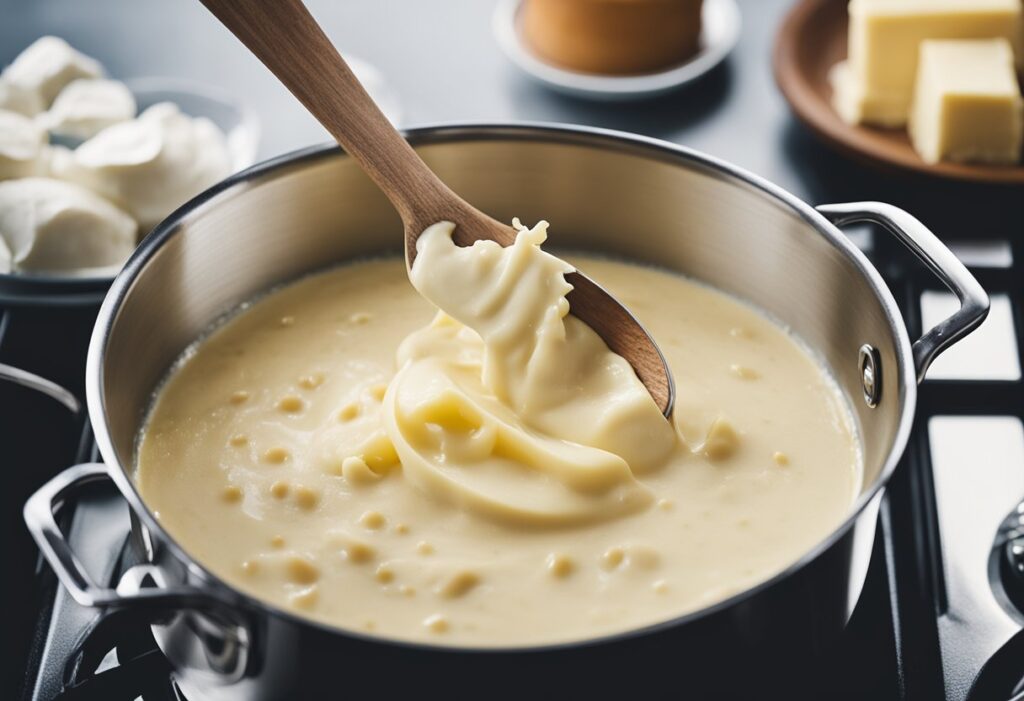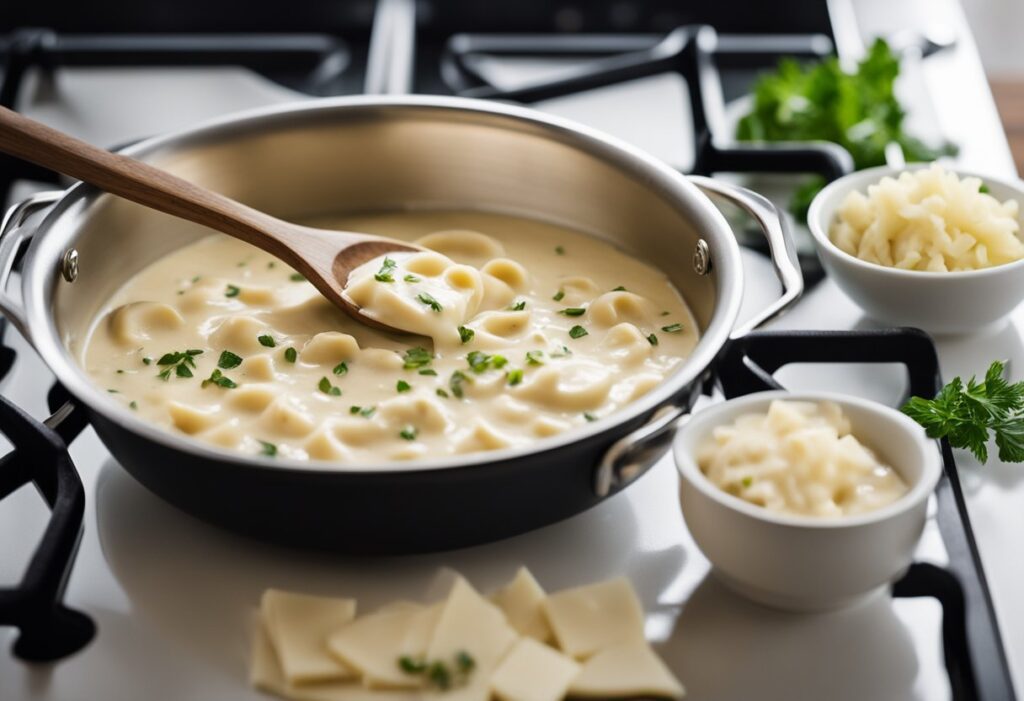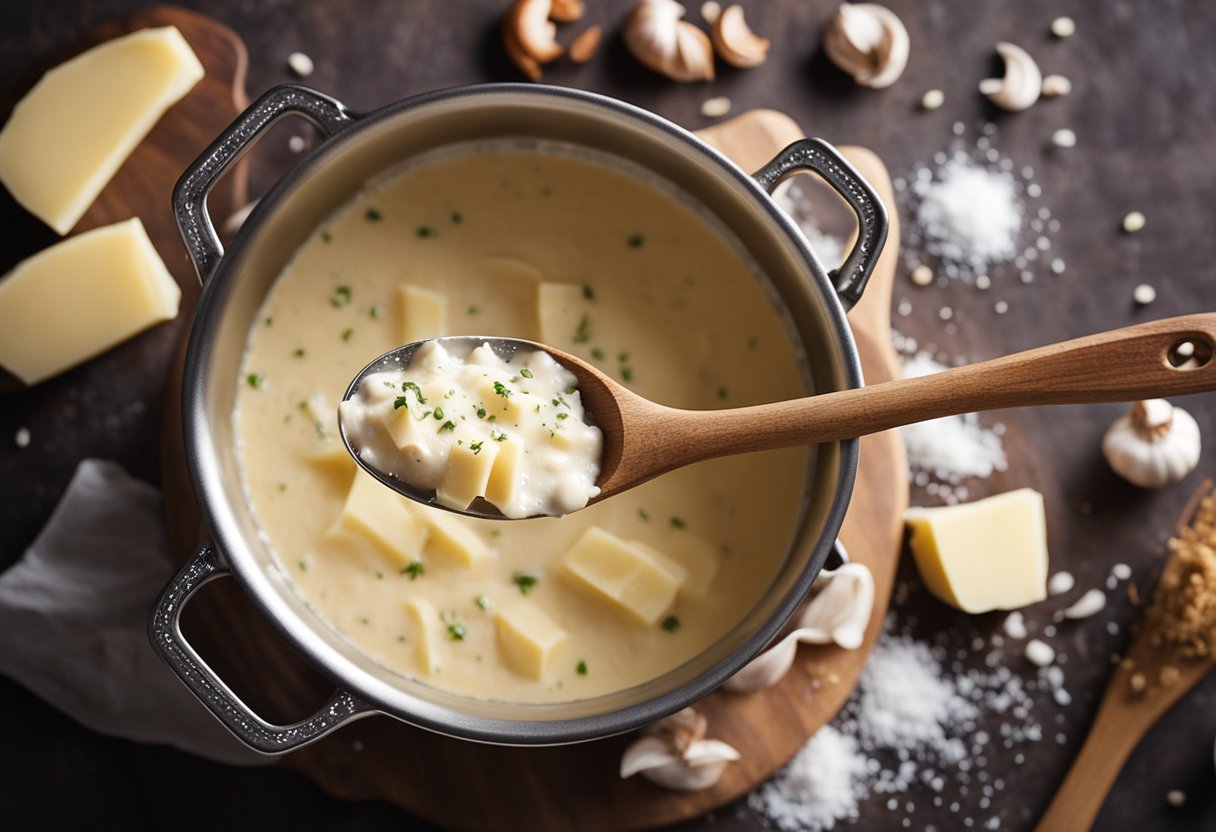Alfredo sauce is a creamy, rich, and indulgent sauce that is typically served with pasta. It is a classic Italian-American dish that has become a popular favorite around the world. The sauce is made from a few simple ingredients, including butter, cream, and Parmesan cheese, and can be customized with additional ingredients to suit individual tastes.
Table of Contents
The origins of Alfredo sauce can be traced back to Rome, where it was created by a man named Alfredo di Lelio in the early 20th century. The original recipe consisted of butter, Parmesan cheese, and fettuccine, and it quickly became a hit among locals and tourists alike. Today, Alfredo sauce is enjoyed in many different variations, with the addition of garlic, herbs, and other ingredients to enhance its flavor.
Making Alfredo sauce at home is surprisingly easy, and allows you to customize the recipe to your liking. Whether you prefer a classic version or something with a little more kick, there are endless possibilities when it comes to this delicious sauce. In this article, we will explore the history of Alfredo sauce, provide step-by-step instructions for making it at home, and offer tips for customizing the recipe to suit your tastes.
History of Alfredo Sauce

Alfredo sauce is a creamy, rich sauce that is typically served with pasta dishes. The sauce is named after Alfredo Di Lelio, an Italian restaurateur who created the recipe in the early 20th century.
Legend has it that Alfredo Di Lelio created the sauce in the 1920s as a way to please his pregnant wife’s cravings. He combined butter, Parmesan cheese, and heavy cream to create a smooth and velvety sauce that was both satisfying and indulgent.
The sauce quickly became popular in Italy and eventually made its way to the United States, where it became a staple in Italian-American cuisine. Today, Alfredo sauce is enjoyed all over the world and is a popular choice for pasta dishes.
While there are many variations of Alfredo sauce, the original recipe remains a classic. It is a testament to the creativity and ingenuity of Italian cuisine and continues to be a beloved sauce for pasta lovers everywhere.
Essential Ingredients

When it comes to making a delicious Alfredo sauce, there are a few essential ingredients that cannot be skipped. The following ingredients are necessary to create a rich and creamy Alfredo sauce:
1. Butter
Butter is a crucial ingredient in Alfredo sauce as it adds richness and flavor. It is recommended to use unsalted butter so that you can control the amount of salt in the sauce.
2. Heavy Cream
Heavy cream is the main ingredient in Alfredo sauce that gives it its creamy texture. It is important to use heavy cream and not half-and-half or milk as they won’t provide the same richness.
3. Parmesan Cheese
Parmesan cheese is a must-have ingredient in Alfredo sauce as it adds a nutty and salty flavor. It is recommended to use freshly grated Parmesan cheese instead of pre-grated cheese as it will melt better and create a smoother sauce.
4. Garlic
Garlic is an optional ingredient in Alfredo sauce, but it adds a depth of flavor that cannot be achieved with other ingredients. It is recommended to use fresh garlic instead of garlic powder for the best flavor.
5. Salt and Pepper
Salt and pepper are essential ingredients in Alfredo sauce as they enhance the flavor of the other ingredients. It is recommended to use freshly ground black pepper and to add salt to taste.
By using these essential ingredients, you can create a delicious and authentic Alfredo sauce that will impress your guests.
Recommended Equipment
To make a delicious Alfredo sauce, one needs to have the right equipment. Here are some essential tools that can help you prepare the perfect Alfredo sauce:
1. Saucepan
A medium-sized saucepan is an essential tool for making Alfredo sauce. It allows you to cook the sauce evenly and prevents it from sticking to the bottom of the pan. A saucepan with a heavy bottom is ideal as it distributes heat evenly and prevents the sauce from burning.
2. Whisk
A whisk is necessary for blending the ingredients of the Alfredo sauce smoothly. It helps to break down any lumps and create a creamy texture. A balloon whisk is ideal for this purpose as it has a large surface area that helps to incorporate air into the sauce.
3. Wooden Spoon
A wooden spoon is an essential tool for stirring the Alfredo sauce. It is gentle on the saucepan and prevents the sauce from sticking to the bottom of the pan. A wooden spoon is also ideal for scraping the sides of the pan to ensure that all the sauce is incorporated.
4. Measuring Cups and Spoons
Measuring cups and spoons are essential for achieving the right balance of ingredients. Accurately measuring the ingredients ensures that the Alfredo sauce has the right consistency and flavor.
5. Grater
A grater is necessary for grating the Parmesan cheese, which is a key ingredient in Alfredo sauce. A microplane grater is ideal for this purpose as it produces a fine texture that melts easily into the sauce.
By having these essential tools, one can create a delicious Alfredo sauce that is smooth and creamy.
Alfredo Sauce Variations

Classic Alfredo
The classic Alfredo sauce is made with butter, cream, and Parmesan cheese. However, there are a few variations that can be made to enhance the flavor. For example, adding garlic or herbs like basil and parsley can give the sauce a more robust flavor. Additionally, substituting heavy cream with half-and-half or whole milk can make the sauce lighter and less rich.
Dairy-Free Alternatives
For those who are lactose intolerant or vegan, there are dairy-free alternatives to the classic Alfredo sauce. One option is to use cashews or silken tofu to create a creamy texture. Nutritional yeast can also be added to give the sauce a cheesy flavor. Another alternative is to use coconut cream or almond milk instead of heavy cream.
Protein-Enhanced Alfredo
To add more protein to the Alfredo sauce, one can incorporate ingredients like chicken, shrimp, or tofu. Grilled chicken or sautéed shrimp can be added to the sauce to make it a complete meal. For vegans, tofu can be used as a protein source. Additionally, adding vegetables like spinach, mushrooms, or broccoli can make the dish more nutritious and flavorful.
Remember, the variations mentioned above are just a few examples of how to customize the classic Alfredo sauce. Experiment with different ingredients and find the perfect variation that suits your taste buds.
Step-by-Step Preparation
Combining Ingredients
To make a delicious alfredo sauce, the first step is to gather all the necessary ingredients. This includes butter, heavy cream, parmesan cheese, garlic, salt, and pepper. Melt butter in a saucepan over medium heat and add minced garlic. Cook for 1-2 minutes until fragrant. Then, add heavy cream and stir until well combined. Gradually add grated parmesan cheese while stirring continuously. Keep stirring until the cheese is melted and the sauce has a smooth texture. Add salt and pepper to taste.
Cooking Techniques
Once the ingredients are combined, it’s time to cook the sauce to perfection. Keep the heat at medium-low and stir the sauce frequently to prevent it from sticking to the bottom of the pan. Cook for 5-7 minutes until the sauce has thickened and has a creamy consistency. Be careful not to overcook the sauce, as it can become too thick and lose its flavor.
Adjusting Thickness
If the sauce is too thick, add a small amount of milk to thin it out. If it’s too thin, add more parmesan cheese and cook for a few more minutes until it thickens. The key is to find the perfect balance between thickness and creaminess. Once the sauce is cooked to perfection, remove it from heat and let it cool for a few minutes before serving.
By following these simple steps, anyone can make a delicious alfredo sauce that will be the perfect addition to any pasta dish.
Serving Suggestions
Pasta Pairings
Alfredo sauce is a versatile sauce that pairs well with a variety of pasta types. Fettuccine is the classic pairing for Alfredo sauce, but it can also be served with other pasta shapes such as linguine, penne, or farfalle. The creamy texture of the sauce complements the pasta’s texture, creating a harmonious dish.
For a more substantial meal, you can add protein to the dish. Grilled chicken, shrimp, or salmon are popular choices that add flavor and texture to the dish. Vegetables such as broccoli, peas, or roasted red peppers can also be added to provide additional color and nutrition.
Garnishing Tips
Garnishing the dish can add visual appeal and enhance the flavor of the dish. Fresh herbs such as parsley, basil, or chives can be finely chopped and sprinkled on top of the dish to add color and freshness. Parmesan cheese can also be grated on top of the pasta to add a salty, nutty flavor.
For a more sophisticated presentation, you can serve the pasta in a bowl or on a plate with a drizzle of olive oil or a sprinkle of red pepper flakes. A few cherry tomatoes or a sprig of rosemary can also be added to the plate for a pop of color.
Overall, Alfredo sauce is a classic and delicious sauce that can be paired with a variety of pasta types and garnished to suit individual tastes.
Storage and Reheating
Once prepared, Alfredo sauce can be stored in an airtight container in the refrigerator for up to five days. Before storing, make sure the sauce has cooled down to room temperature. It is recommended to store the sauce in smaller portions, so you can reheat only what you need.
To reheat Alfredo sauce, gently warm it up in a saucepan over low heat, stirring occasionally. Avoid overheating the sauce as this can cause it to separate and become oily. If the sauce appears too thick, add a small amount of milk or cream to adjust the consistency.
If you have leftover pasta with Alfredo sauce, store them separately. Cooked pasta can be stored in an airtight container in the refrigerator for up to three days. To reheat, bring a pot of salted water to a boil and add the pasta. Cook for a few minutes until heated through, then drain and mix with the reheated sauce.
It is not recommended to freeze Alfredo sauce, as the texture and flavor can be affected. However, if you must freeze it, store it in an airtight container and consume it within a month. To thaw, place the container in the refrigerator overnight and reheat as instructed above.
Common Mistakes to Avoid
When making Alfredo sauce, there are a few common mistakes that can ruin the dish. Here are some things to keep in mind to ensure that your Alfredo sauce turns out perfectly:
Using the Wrong Cheese
One of the most common mistakes when making Alfredo sauce is using the wrong type of cheese. While some recipes call for Parmesan cheese, others call for Romano or Asiago cheese. It’s important to use the correct type of cheese to get the right flavor and texture. Using a cheese that is too strong or too mild can throw off the balance of the dish.
Cooking the Sauce Too Long
Another common mistake is cooking the sauce for too long. Overcooking the sauce can cause it to become too thick and clumpy. It’s important to cook the sauce just until it thickens and coats the back of a spoon. If the sauce becomes too thick, you can thin it out with a little bit of milk or cream.
Not Using Enough Butter
Alfredo sauce is made with butter, cream, and cheese. If you don’t use enough butter, the sauce can be too thin and lack flavor. It’s important to use enough butter to create a rich and creamy sauce.
Adding Garlic Too Early
Garlic is a common ingredient in Alfredo sauce, but adding it too early can cause it to burn and become bitter. It’s best to add the garlic towards the end of cooking to prevent this from happening.
By avoiding these common mistakes, you can make a delicious Alfredo sauce that will impress your friends and family.
Nutritional Information
When it comes to Alfredo sauce, it’s no secret that it’s not the healthiest option out there. However, with a few tweaks, you can make it a bit more nutritious. Here’s a breakdown of the nutritional information for a standard Alfredo sauce recipe:
- Calories: A typical serving of Alfredo sauce contains around 400-500 calories.
- Fat: Alfredo sauce is known for its high fat content, with a typical serving containing around 30-40 grams of fat.
- Protein: A serving of Alfredo sauce typically contains around 10-15 grams of protein.
- Carbohydrates: Alfredo sauce is not typically high in carbohydrates, with a serving containing around 10-15 grams.
To make Alfredo sauce a bit more nutritious, consider using low-fat milk or cream, and adding in some veggies like spinach or broccoli. You can also opt for whole wheat pasta instead of regular pasta to add some extra fiber to the dish.
Overall, while Alfredo sauce may not be the healthiest option out there, with a few tweaks, you can still enjoy this classic dish without completely throwing your diet out the window.

